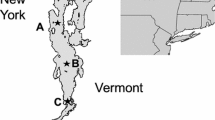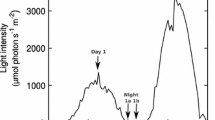Summary
We present a statistical analysis of a previously published (Yen, 1983) but heretofore unanalyzed data set on the vertical distributions and diel vertical migration (DVM) of adult females of the marine planktonic copepod Euchaeta elongata in Dabob Bay, Washington, USA. Non-ovigerous females were strongly migratory on all four dates sampled, residing between 75–175 m during the day and at shallower depths during the night, commonly entering the upper 50 m of the water column. In contrast, ovigerous females were non-migratory or weakly migratory, largely remaining between 100–175 m both day and night, and entering the upper 50 m of the water column only rarely. Thus non-ovigerous females always migrated much more strongly, as measured by both amplitude of migration and the proportion of animals migrating, than did ovigerous females. These results led us to hypothesize that differential susceptibility to visually orienting predators was the cause of these differences in DVM behavior in female E. elongata, and we subsequently undertook an experimental study of the feeding selectivity of the copepod's natural predator, Pacific herring (Clupea harengus pallasi). Pacific herring exhibited a highly significant preference for ovigerous over nonovigerous adult female E. elongata. The demographic consequences of variable DVM in adult female E. elongata were investigated by way of life table analyses. Results indicated that under conditions of thermal stratification of the water column there is a distinct demographic disadvantage (reduced rate of realized population growth) incurred by non-migratory or weakly migratory ovigerous females due to delayed egg development at cooler subsurface temperatures. We conclude that ovigerous female E. elongata remain at depth both day and night to avoid visually orienting predators, and that such behavior must afford the copepod a demographic advantage of no less than a 26% reduction in adult mortality to offset the demographic cost of delayed egg development.
Similar content being viewed by others
References
Apollonio S, Stevenson DK, Dunton EE Jr (1986) Effects of temperature on the biology of the northern shrimp, Pandalus borealis, in the Gulf of Maine. US Commerce Dept., NOAA Tech. Rept. NMFS 42, Washington, DC, 22 pp.
Bohl E (1982) Food supply and prey selection in planktivorous Cyprinidae. Oecologia 53:134–138
Bollens SM, Frost BW (1989a) Zooplanktivorous fish and variable diel vertical migration in the marine planktonic copepod Calanus pacificus. Limnol. Oceanogr 34:1072–1083
Bollens SM, Frost BW (1989b) Predator-induced diel vertical migration in a planktonic copepod. J Plankton Res 11:1047–1065
Blaxter JHS, Hunter JR (1982) The biology of the clupeoid fishes. Adv Mar Biol 20:1–223
Brooks JL (1968) The effects of prey size selection by lake plank-tivores. Syst Zool 17:278–291
Burgis M (1970) The effect of temperature on the developmental time of Thermocyclops sp., a tropical cyclopoid copepod from Lake george, Uganda. Limnol Oceanogr 15:742–747
Damkaer DM (1964) Vertical distribution of copepods in Dabob Bay, December 1960. MS Thesis, Univer. Washington, Seattle
Dawidowicz P, Gliwicz ZM (1983) Food of brook charr in extreme oligotrophic conditions of an alpine lake. Environ Biol Fish 8:55–60
Doble BD, Eggers DM (1978) Diel feeding chronology, rate of gastric evacuation, daily ration, and prey selectivity in Lake Washington juvenile sockeye salmon (Oncorhynchus nerka). Trans Am Fish Soc 107:36–45
Drenner RW, Strickler JR, O'Brien WJ (1978) Capture probability: the role of zooplankter escape in the selective feeding of planktivorous fish. J Fish Res Bd Can 34:1370–1373
Edmondson WT (1960) Reproductive rate of rotifers in natural populations. Mem Ist Ital Idrobiol 12:21–77
Eggers DM (1982) Planktivore preference by prey size. Ecology 63:381–390
Frost BW (1988) Variability and possible adaptive significance of diel vertical migration in Calanus pacificus, a planktonic marine copepod. Bull Mar Sci 43:675–694
Galbraith MG Jr (1967) Size-selective predation on Daphnia by rainbow trout and yellow perch. Trans Am Fish Soc 96:1–10
Gliwicz ZM (1981) Food and predation in limiting clutch size of cladocerans. Verth Internat Verein Limnol 21:1562–1566
Hairston NG Jr, Walton WE, Li KT (1983) The causes and consequences of sex-specific mortality in a freshwater copepod. Limnol Occanogr 28:935–947
Hutchinson GE (1967) A treatise on limnology. Vol. II. Introduction to lake biology and the limnoplankton. New York: John Wiley & Sons, Inc. 1115 pp
Kislalioglu K, Gibson RN (1976) Some factors governing prey selection by the 15-spined stickleback, Spinachia spinachia (L.). J Exp Mar Biol Ecol 25:159–169
Koslow JA (1981) Feeding selectivity in schools of northern anchovy (Engraulis mordax) in the southern California Bight. Fish Bull, US 79:131–142
Koufopanou V, Bell G (1984) Measuring the cost of reproduction. IV. predation experiments with Daphnia pulex. Oecologia 64:81–86
Landry MR (1983) The development of marine calanoid copepods with comment on the iscohronal rule. Limnol Oceanogr 28:614–624
McLaren IA (1974) Demographic strategy of vertical migration by a marine copepod. Am Nat 108:91–102
Mittlebach GG (1981) Foraging efficiency and body size: a study of optimal diet and habitat use by bluegills. Ecology 62:1370–1386
Mellors WK (1975) Selective predation on ephippial Daphnia and the resistance of ephippial eggs to digestion. Ecology 56:974–980
Miller CB, Frost BW, Batchelder HP, Clemons MJ, Conway RE (1984) Life histories of large, grazing copepods in a subarctic gyre: Neocalanus plumchrus, Neocalanus cristatus, and Eucalanus bungii in the northeast Pacific. Progr Oceanogr 13:201–243
Nicholls AG (1933) On the biology of Calanus finmarchicus. III Vertical distribution and diurnal migration in the Clyde Seaarea. J Mar Biol Assoc UK 19:139–164
Ohman MD, Frost BW, Cohen EB (1983) Reverse diel vertical migration: an escape from invertebrate predators. Science 220:1404–1407
Ohman MD (1986) Predator-limited population growth of the copepod Pseudocalanus sp. J Plankton Res. 8:673–713
Ohman MD (1990) The demographic benefits of diel vertical migration by zooplankton. Ecol Monogr
Rotenberry JT, Weins JA (1985) Statistical power analysis and community-wide patterns. Am Nat 125:164–168
Sandstrom O (1980) Selective feeding by Baltic herring. Hydrobiologia 69:199–207
Sekiguchi H (1974) Relation between the ontogenetic vertical migration and the mandibular gnathobase in pelagic copepods. Bull Fac Fish Mie Univ 1:1–10
Sokal RP, Rohlf FJ (1981) Biometry. New York: W. H. Freeman and Company.
Tucker RP, Woolpy SP (1984) The effect of parthenogenic eggs in Daphnia magna on prey location by the bluegill sunfish (Lepomis macrochirus). Hydrobiologia 109:215–217
Uye S, Huang C, Onbe T (1990) Ontogenetic diel vertical migration of the planktonic copepod Calanus sinicus in the Inland Sea of Japan. Mar Biol 104:389–396
Vinyard GL, O'Brien WJ (1975) Dorsal light response as an index of prey preference in Bluegill (Lepomis macrochirus). J Fish Res Bd Can 32:1860–1863
Vuorinen I (1987) Vertical migration of Eurytemora (Crustacea, Copepoda): a compromise between the risks of predation and decreased fecundity. J Plankton Res 9:1037–1046
Vuorinen I, Rajasilta M, Salo J (1983) Selective predation and habitat shift in a copepod species — support for the predation hypothesis. Oecologia 59:62–64
Winfield IJ, Townsend CR (1983) The cost of copepod reproduction: increased susceptibility to fish predation. Oecologia 60:406–411
Yen J (1982) Predatory feeding ecology of Euchaeta elongata Esterly, a marine planktonic copepod. Ph.D. Thesis, Univ. Washington, Seattle
Yen J (1983) Effects of prey concentration, prey size, predator life stage, predator starvation, and season on predation rates of the carnivorous copepod Euchaeta elongata. Mar Biol 75:69–77
Yen J (1985) Selective predation by the carnivorous marine copepod Euchaeta elongata: laboratory measurements of predation rates verified by field observations of temporal and spatial feeding patterns. Limnol Oceanogr 30:577–597
Zaret TM (1972) Predators, invisible prey, and the nature of polymorphism in the Cladocera (Class Crustacea). Limnol Oceanogr 17:171–184
Author information
Authors and Affiliations
Rights and permissions
About this article
Cite this article
Bollens, S.M., Frost, B.W. Ovigerity, selective predation, and variable diel vertical migration in Euchaeta elongata (Copepoda: Calanoida). Oecologia 87, 155–161 (1991). https://doi.org/10.1007/BF00325252
Received:
Accepted:
Issue Date:
DOI: https://doi.org/10.1007/BF00325252




